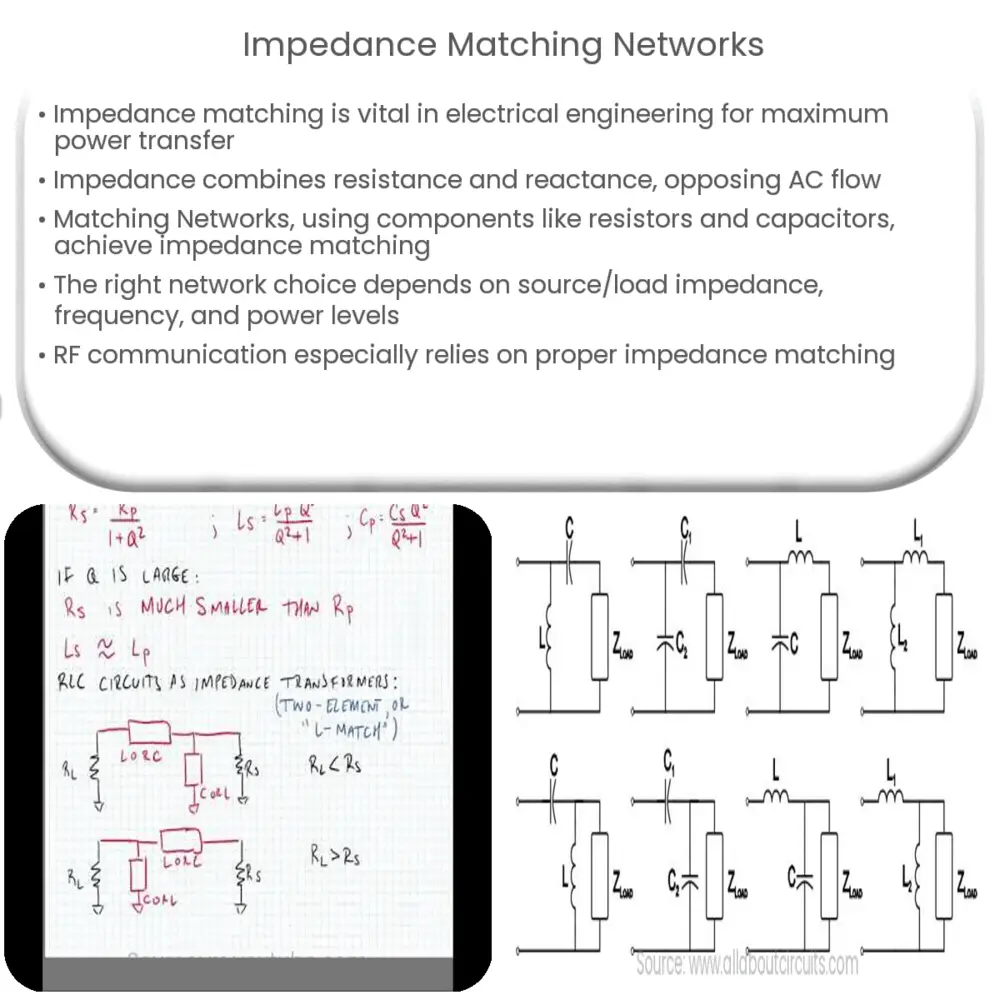Explore the concept of Impedance Matching Networks, their types, significance in electrical engineering, and their role in RF and wireless communication.

Understanding Impedance Matching Networks
Impedance matching is a fundamental concept in electrical engineering that ensures maximum power transfer from a source to a load. It occurs when the impedance of a source circuit matches the impedance of a connected load circuit. But why is this important? This article seeks to provide insight into the subject of Impedance Matching Networks.
The Concept of Impedance
Impedance, denoted as Z, is a measure that combines resistance and reactance (resistive and reactive components) of an electrical circuit when alternating current (AC) is applied. It’s a complex value that represents the total opposition that a circuit presents to the flow of alternating current. The unit of impedance is the ohm (Ω), same as resistance.
The Need for Impedance Matching
Impedance matching is crucial for several reasons. Firstly, it ensures that an electrical system can operate efficiently and effectively by minimizing signal reflections and optimizing power transfer. Signal reflections occur when there’s a mismatch between the source and load impedance, leading to signal loss and possible system damage.
Impedance Matching Networks
Impedance Matching Networks, or simply Matching Networks, are circuits employed to accomplish impedance matching. These networks are crafted using components like resistors, capacitors, and inductors. The matching networks come in various configurations, with the most common ones being:
- L-section
- π (Pi) network
- T-section
- Π (Delta) network
Each of these networks serves different purposes and scenarios depending on the source and load impedances.
Types of Matching Networks
- L-section Matching Network: It is the simplest form of matching network, consisting of two reactive elements, typically an inductor and a capacitor. This network type is usually employed in scenarios where the source and load impedances are purely real and not equal.
- π (Pi) Network: The π-network is a three-element matching network. It’s often used in radio frequency (RF) applications and high power amplifiers.
Each type of Matching Network holds its unique features and application areas. The choice depends largely on the specific requirements of the electrical system in question. In the upcoming sections, we’ll explore more on this topic.
Continuation of Types of Matching Networks
- T-section Matching Network: This configuration is analogous to the π-network but flipped. The T-network can be employed in a range of applications where impedance transformation over a broad bandwidth is required.
- Π (Delta) Network: The Π network is similar to the T-section but configured differently. It is used in cases where the load impedance is greater than the source impedance.
Selection of the Appropriate Matching Network
Choosing the right matching network for a specific application is determined by various factors, including the nature of the source and load impedance, the frequency of operation, power levels, and the required bandwidth. Detailed knowledge about the specific characteristics of each network type aids in making an informed decision.
Impedance Matching in RF and Wireless Communication
Impedance matching is especially crucial in the field of radio frequency (RF) and wireless communication. Here, the transmission lines or antennas must be properly matched to ensure maximum power transmission and to prevent signal reflections. Consequently, impedance matching networks play a key role in designing RF circuits and systems.
The Role of Smith Chart in Impedance Matching
The Smith Chart is a graphical tool used for solving problems related to transmission lines and matching networks. It enables engineers to visualize the changes in impedance, facilitating the design and analysis of impedance matching networks.
Conclusion
In conclusion, the science of impedance matching networks is an essential domain in electrical engineering, contributing significantly to the overall system efficiency and functionality. Whether it’s the simple L-section, the versatile π-network, or the robust T-section and Π-network, each configuration has a significant role in diverse applications. An in-depth understanding of these networks, coupled with tools like the Smith Chart, empowers engineers to optimize designs for maximum power transfer and minimum signal reflection. The fundamental principle of impedance matching remains constant: the harmonious interaction of source and load for efficient energy transfer.

